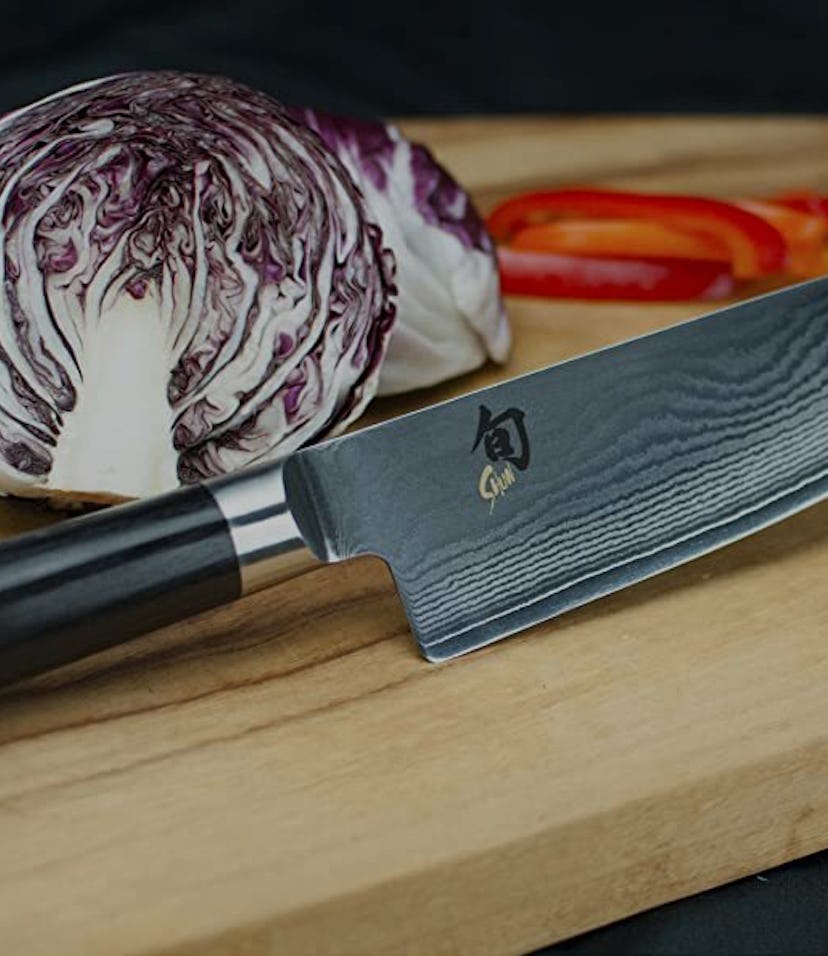This Thing Rules
I'm addicted to slicing and dicing with Shun's Classic Chef Knife
Throw your $10 Ikea knife set in the trash. Knives made by Shun make chopping up veggies equal parts sharp and sexy.

For anyone even slightly interested in upping their cooking game, Knife Envy is inevitable. Watching a trained chef use a flashy piece of sharpened steel to slice through an onion is like seeing a pro sport for the first time — everything after the fact looks like little league.
I’m fairly progressed in my journey as a dude who cosplays as a chef (I’ve got the Le Creuset to prove it), and while Knife Envy, the coolest of all the deadly kitchen sins, still creeps up from time to time, I’ve got one shiny, sexy, ready-to-cut-your-finger-off tool that keeps my jealousy at bay.
I’m talking about Shun’s Classic Chef’s Knife — possibly the greatest chef knife of all time. At least, the best one I own.
Input may receive a portion of sales if you purchase a product through a link in this article. We only include products that have been independently selected by Input’s editorial team.
Thanks to some expert level gift-giving from my brother, I’ve had not one, but two Shun knives — an 8-inch Classic Chef’s Knife and the smaller 7-inch Cook’s Knife — for a few years now, and they’ve easily become the most irreplaceable pieces of kitchenware that I own.
Part of what makes Shun knives so amazing is (obviously) the sharpness. Japanese blades like those made by Shun are sharpened to a 16-degree angle on either side as opposed to many German blades which run about 20-degrees.
That angle not only makes them razor-sharp, but also highly precise. Watch this video of me dicing up an onion using Shun’s 7-inch cook’s knife and notice how thin I’m able to get the finishing lateral slices.
The angle and sharpness of Shun’s knives also means they’re Rob Thomas smooth. Crosswise cuts through a potato are easy and stress-free. Tomatoes? The Shun glides through like butter. Butter? Well, butter doesn’t even exist on an atomic level when Shun’s knives are involved.
Sharpness isn’t the only metric by which Shun excels either. Both knives I own are also expertly balanced.
If you’re holding your knife correctly (and you should be, considering these could potentially alter your handshake for life) the blade and the handle ought to be counter-balanced against one another.
To test the balance of a knife, you can grip it at the intersection of where the handle and the blade meet like you would if you were ready to begin slicing (thumb on one side and the flat side of your index fingers pressed against the other). If the knife is well-made, like the Shun is, it won’t see-saw, it’ll rest comfortably in your hand with a kind of assured equilibrium.
If you’re like me and have relatively small-to-regular-sized hands, Shun’s chef knives are also a perfect choice. Both of the blades I own are thin and incredibly light, making them easy to grip and maneuver.
While you don’t technically need to have two all-purpose knives, owning the smaller 7-inch cook’s knife has been an incredible luxury.
For instance, if I’m doing something more delicate like filleting short ribs to make kalbi, the smaller, more easily manipulated blade makes each cut precise and measured, allowing me to unfurl the meat piece-by-piece without ever fully severing it.
Likewise, the weight and size of the larger chef’s knife makes everyday stuff like dicing an onion or a carrot feel very low-lift.
Tomatoes? The Shun glides through like butter.
There are some downsides to all that precision and sharpness, of course. The steeper angle of Shun’s blades does make them more fragile and slightly harder to sharpen. As a result, you’ll probably want to have your knives tuned up by a professional as opposed to busting out the whetstone at home.
If you’re not the type of person to bring their knives in for a sharpening on a semi-regular basis, you can spring for any knife made from Shun’s own proprietary steel called, “VG-Max” which adds more carbon to the alloy mix for increased durability. Both of my knives are made from the VG-Max blend and have been more than sufficient for my (very regular) level of usage.
In the end, Shun knives’ durability can hardly be considered a trade-off when you weigh it against just how luxurious the knives feel and function.
Cooking is something most people need to do on a regular basis, but just because it can feel like a chore doesn’t mean you shouldn’t feel like a pro when you do it. I can’t say for certain whether you’ll ever be a Top Chef or not, but my personal advice is to buy a Shun knife and an onion and get choppin’.
This article was originally published on